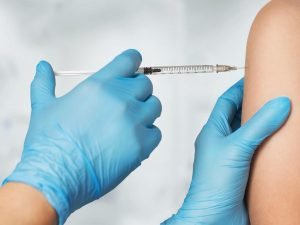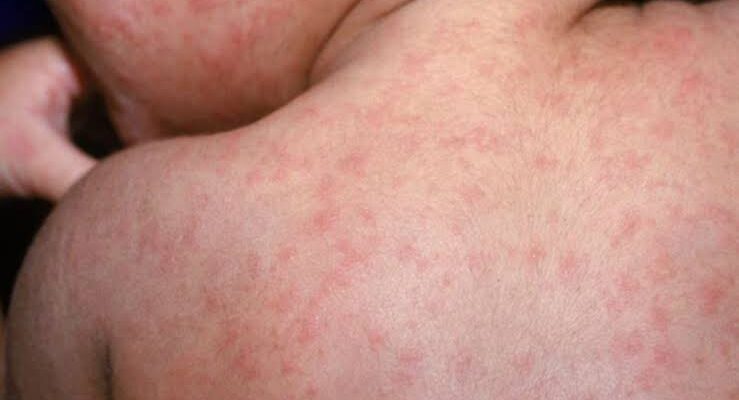Summary
One of the most contagious diseases in developing and tropical countries is measles, a highly infectious illness caused by the rubeola virus. Measles can spread rapidly in communities, particularly where vaccination rates are low. The virus is airborne and can infect anyone not protected by vaccination. It enters the body through the nose, eyes, or mouth when an individual breathes in contaminated air. Additionally, measles can be contracted by touching surfaces or objects contaminated with the virus and then touching the eyes, nose, or mouth.
The symptoms of measles include high fever, joint pain, rash, coughing, sneezing, watery eyes, and even dizziness. The characteristic rash usually begins on the face and spreads downward to cover most of the body. These symptoms generally appear about 10 to 14 days after exposure to the virus, and measles can lead to severe complications like pneumonia, encephalitis (swelling of the brain), and, in rare cases, death, especially in young children and those with weakened immune systems.
Although there is currently no cure for measles, it is preventable through vaccination. The measles vaccine, which is typically given as part of the MMR (measles, mumps, rubella) vaccine, is highly effective, with a success rate of approximately 97% in preventing measles infection. Widespread vaccination has proven critical in reducing measles outbreaks globally, making immunization an essential public health strategy to control and eventually eliminate this contagious disease.
Table of Contents
Symptoms of Measles
 Image Source: www.getsickcure.com
Image Source: www.getsickcure.com
Measles symptoms usually begin to appear between the 7th and 14th day after exposure to the virus. This period marks the initial phase of infection, where early signs become noticeable and gradually intensify.
Symptoms from Day 7 to Day 14. During this time, initial symptoms typically include high fever, coughing, runny nose, and red, watery eyes. These symptoms often resemble those of a common cold but are usually more intense and persistent.
Koplik spots. Around two to three days after symptoms first appear, small white spots with a bluish center—known as Koplik spots—may be visible inside the mouth, especially on the inner cheeks. Koplik spots are a unique early indicator of measles and help differentiate it from other illnesses.
Measles rash. Three to five days after initial symptoms, a distinctive red rash begins to spread across the body. Starting on the face and moving downwards, the rash can cover most of the body, becoming dense and red in color before gradually fading.
Measles progresses quickly, and its symptoms can be severe, particularly in children and individuals with weakened immune systems. Early recognition of these symptoms is essential for prompt care and preventing further spread of the virus.
Types of Measles
Measles has two main types, each with distinct causes and potential complications. While some symptoms may appear similar, the two types of measles differ in severity and impact.
Red measles. When people refer to measles, they are typically referring to red measles, also known as “hard measles.” This form of measles is caused by the rubeola virus and tends to be more severe. Complications can arise if the infection progresses, including ear infections, pneumonia, or even encephalitis (brain inflammation), which can lead to long-term health issues or be life-threatening.
German measles. German measles, or “three-day measles,” is caused by the rubella virus and is generally milder than red measles. However, it poses significant risks for pregnant women, as infection during pregnancy can lead to serious health conditions in the unborn child, including congenital rubella syndrome (CRS), which may cause heart defects, vision and hearing loss, or developmental delays.
Understanding these differences is important, especially in preventing severe outcomes through vaccination and protecting vulnerable populations, such as young children and pregnant women, from these infections.
Diagnostic Procedures for Measles
Diagnosing measles involves a combination of clinical examination, symptom assessment, and laboratory tests. Early and accurate diagnosis is crucial to prevent the spread of this highly contagious virus and to manage symptoms effectively.
- Clinical examination and symptom assessment. Physicians begin by examining the patient for characteristic signs of measles, such as high fever, cough, runny nose, red and watery eyes, and the appearance of a red rash that typically spreads from the face to the rest of the body. Small white spots known as Koplik spots inside the mouth are a specific indicator of measles and help differentiate it from similar illnesses.
- Medical history and exposure assessment. Doctors will inquire about recent travel to areas with measles outbreaks, vaccination status, and any known exposure to infected individuals. This helps determine the likelihood of measles infection, especially if the patient is unvaccinated or in contact with other cases.
- Blood test for measles-specific antibodies. A blood test is often conducted to detect measles-specific IgM and IgG antibodies. Elevated IgM antibodies typically indicate a recent infection, while IgG antibodies can help determine immunity. This test is especially useful in confirming cases when symptoms are not definitive.
- Polymerase chain reaction (PCR) testing. PCR testing of blood, throat swabs, or nasal secretions can identify the presence of the measles virus’ genetic material. PCR is a highly sensitive and accurate method that allows for rapid confirmation of infection, often within days of symptom onset.
- Viral culture (in some cases). In certain instances, a viral culture may be performed to isolate the measles virus from a throat or nasal swab sample. Although less common due to longer processing times, viral culture can be useful in outbreak investigations or when confirming cases is essential for public health tracking.
Accurate diagnosis of measles is essential for timely treatment and to prevent further spread of the virus. Laboratory tests, combined with clinical signs and exposure history, help health professionals confirm cases and implement necessary preventive measures.
Complications of Untreated Measles
If left untreated, measles can lead to severe and potentially life-threatening complications, especially in young children, pregnant women, and those with weakened immune systems. The virus can affect multiple systems in the body, resulting in both immediate and long-term health issues.
- Pneumonia. Measles can lead to viral or bacterial pneumonia, a serious lung infection and one of the leading causes of death in measles cases. Young children and individuals with weakened immune systems are particularly vulnerable to pneumonia caused by the measles virus.
- Encephalitis. Encephalitis, or inflammation of the brain, is a rare but serious complication of measles. It can occur shortly after infection or even months later and may cause seizures, permanent brain damage, or, in severe cases, death.
- Ear infections. Measles often leads to middle ear infections (otitis media), especially in children. These infections can cause ear pain, hearing loss, and, if untreated, may result in permanent hearing damage.
- Severe diarrhea and dehydration. Untreated measles can cause severe diarrhea, which may lead to dehydration, particularly in young children. This complication can be life-threatening if not managed promptly, as dehydration can quickly affect organ function.
- Blindness. Measles can cause eye infections and, in some cases, severe damage to the cornea, leading to blindness. This complication is more common in people with vitamin A deficiency, which is why vitamin A supplementation is often recommended during measles infection.
- Subacute sclerosing panencephalitis (SSPE). SSPE is a rare but fatal brain disorder that can occur several years after measles infection. This progressive condition leads to neurological deterioration, including changes in behavior, seizures, and loss of motor skills.
- Complications during pregnancy. Pregnant women who contract measles face an increased risk of miscarriage, premature birth, or low birth weight. Measles infection during pregnancy can also pose risks to the baby’s health.
Untreated measles can lead to a cascade of health issues, highlighting the importance of timely medical care and vaccination. Early intervention and supportive treatments help reduce the severity of symptoms and prevent many of these complications, making vaccination the best defense against this highly contagious disease.
Causes of Measles
Measles is highly contagious, primarily due to the rubeola virus, which multiplies in the nose and throat of an infected person. The virus spreads through respiratory droplets released during coughing, sneezing, or even breathing. Anyone who inhales these droplets, especially those unvaccinated, is at high risk of contracting the disease.
The virus can also survive outside the body for a short period. When respiratory droplets land on surfaces, they can remain infectious for several minutes. If another person touches a contaminated surface and then touches their eyes, nose, or mouth, the virus can enter their body, leading to infection.
Transmission occurs easily through the eyes, nose, or mouth, especially when unwashed hands come into contact with these areas after touching contaminated objects or surfaces. Given how quickly it spreads, vaccination is essential in protecting against measles and preventing its rapid transmission in communities.
Prevention of Measles
 Image Source: www.independent.co.uk
Image Source: www.independent.co.uk
Vaccination is the most effective measure for preventing measles, a highly contagious viral infection that spreads rapidly among unvaccinated individuals. With the availability of two primary vaccines, MMR and MMRV, it is possible to protect against measles and other related infections. For individuals who cannot receive the vaccine, additional preventive practices can help reduce the risk of infection and limit the spread of the virus in communities. Here is an overview of the vaccines and recommended preventive measures to help protect against measles.
The best way to prevent measles is through vaccination. Two primary vaccines offer protection against measles: the MMR and MMRV vaccines.
MMR vaccine. This is a three-in-one vaccine that provides immunity against measles, mumps, and rubella. It is typically administered in two doses, with high effectiveness in preventing these diseases.
MMRV vaccine. This vaccine provides protection against measles, mumps, rubella, and chickenpox (varicella), making it a four-in-one option for comprehensive coverage. The MMRV vaccine is often recommended for children as part of routine immunization schedules.
Other Ways to Prevent Measles
For individuals who cannot be vaccinated, additional measures can help reduce the risk of measles infection. Practicing the following preventive steps is important, especially during outbreaks:
- Practice proper hand hygiene. Regularly wash hands thoroughly with soap and water, particularly before eating, after using the restroom, and before touching the face, mouth, or nose. Proper hand hygiene reduces the risk of contact with viral particles.
- Avoid sharing personal items with those who have measles. Measles is highly contagious, and surfaces or items touched by an infected person may harbor the virus, posing a risk to others.
- Avoid close contact with individuals who have measles. Since the virus spreads easily through respiratory droplets from coughing, sneezing, or even breathing, staying out of the same room or maintaining distance from infected individuals can help prevent transmission.
While vaccination remains the most effective method to prevent measles, following these additional hygiene and distancing measures helps protect vulnerable individuals and reduces the spread of this highly contagious virus.
Risk Factors for Measles
Regardless of age, an unvaccinated person has a 90% chance of contracting measles if exposed to the virus. Several additional factors increase the risk of contracting measles, especially for certain groups who are more vulnerable to infection:
- Being an infant. Infants are too young to mount a protective immune response from the measles vaccine, meaning they cannot be vaccinated and are therefore at higher risk of contracting measles if exposed.
- Inability to receive the vaccine due to immune conditions. Certain individuals cannot receive the measles vaccine due to compromised immune systems, such as those undergoing chemotherapy for cancer. Without vaccination, they remain susceptible to infection.
- Incomplete vaccination series. The measles vaccine requires a booster dose for maximum effectiveness. While the first dose provides about 93% immunity, the second dose boosts effectiveness to 97%, making full vaccination critical for optimal protection.
- Lack of immune response to vaccination. A small percentage of people may not develop immunity to measles even after vaccination, leaving them vulnerable to infection despite immunization.
- Weakened immune system. Conditions that impair the immune system, such as HIV/AIDS, make individuals more susceptible to infections, including measles, as their body’s ability to fight viruses is significantly compromised.
- Vitamin A deficiency. Lack of adequate vitamin A in the diet can worsen measles symptoms if a person becomes infected, as vitamin A is crucial for immune function and recovery.
- Travel to areas with high measles transmission. Individuals who travel to regions with active measles outbreaks are at increased risk, especially if they are not fully vaccinated or have low immunity.
These risk factors underscore the importance of widespread vaccination, particularly in vulnerable populations, to prevent measles transmission and protect those who cannot receive the vaccine.
Measles FAQs
Measles is a highly contagious viral disease known for its characteristic red rash and severe complications in some cases. Despite the availability of an effective vaccine, outbreaks still occur, especially in areas with low vaccination coverage. Here are some frequently asked questions about measles, covering its symptoms, prevention, and treatment options.
- What is measles?
Measles is a viral infection caused by the rubeola virus. It spreads easily through respiratory droplets from an infected person’s coughs or sneezes and can lead to serious complications, especially in young children and those with weakened immune systems. - What are the symptoms of measles?
Symptoms include high fever, cough, runny nose, red and watery eyes, small white Koplik spots inside the mouth, and a red rash that spreads from the face downwards to the rest of the body. - How does measles spread?
Measles spreads through the air via respiratory droplets and can survive on surfaces for a few minutes. Unvaccinated individuals who come into contact with the virus through breathing, touching contaminated surfaces, or being near an infected person can easily contract the disease. - Who is at the highest risk for measles?
Those most at risk include infants too young for vaccination, individuals with weakened immune systems, those who are unvaccinated or only partially vaccinated, and people with vitamin A deficiency. - Can measles be prevented?
Yes, the measles vaccine, given as part of the MMR or MMRV vaccine, is highly effective. Vaccination has an efficacy rate of around 93% after the first dose and 97% after the second, making it the best preventive measure against measles. - What complications can measles cause?
Measles can lead to severe complications like pneumonia, encephalitis (brain inflammation), hearing loss, and even death, particularly in young children and people with weakened immune systems. - How is measles treated?
There is no specific cure for measles. Treatment focuses on managing symptoms and complications through hydration, fever reduction, and in some cases, vitamin A supplementation, which can reduce the severity of symptoms. - Why is vitamin A important in measles treatment?
Vitamin A helps support the immune system, and supplementing it can help reduce the severity of measles symptoms and lower the risk of complications, especially in children with low vitamin A levels. - Can vaccinated people get measles?
In rare cases, vaccinated people may still contract measles, though the chances are very low. Full vaccination (two doses) significantly reduces the risk of infection and, if infection does occur, tends to result in a milder illness. - Is measles still a global health concern?
Yes, measles remains a concern, especially in areas with low vaccination rates. Outbreaks can happen in any community where vaccination coverage is insufficient, making global vaccination efforts essential for preventing the spread.


